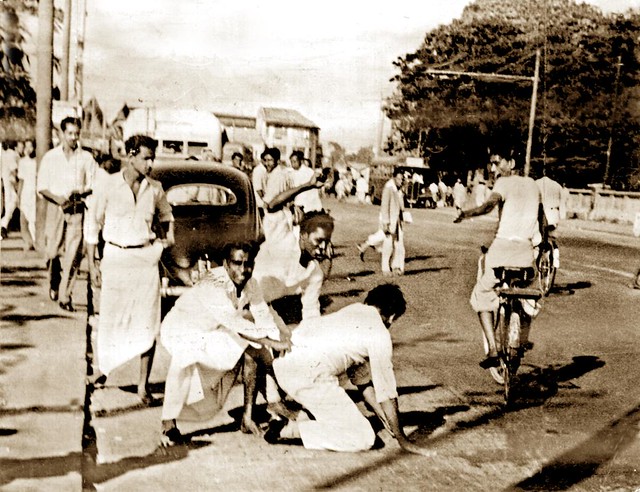
Photograph: A Sinhalese mob beats a Tamil passenger after pulling him out of his car. 1958. (Courtesy Victor Ivan)
On this day in 1958, Sinhala mobs began to attack, rape and murder Tamils across the island, in what was to become another in a series of deadly anti-Tamil pogroms.
Estimates range from between 300 and 1,500 Tamils murdered in the days of violence which resulted in many more injured and the arson, looting and destruction of Tamil homes and businesses.
The pogrom took place just two years after the island’s first ethnic based pogrom against Tamils in 1956. The violence reportedly started in Polonnaruwa on 22 May 1958, as Sinhala mobs looked to attack Tamils who were on their way to the Federal Party convention in Vavuniya.
Violence then spread across the whole island. A Hindu priest was burnt alive in Colombo, whilst mobs roamed the streets of Colombo checking whether passers-by could read Sinhala newspapers. Those who could not were beaten or killed. The government waited five days before declaring an emergency.
Velupillai Prabhakaran, the leader of the Liberation Tigers of Tamil Eelam, cited the 1958 pogroms as being instrumental in shaping his political outlook.
See excerpts from a March 1984 interview with Prabhakaran below.
“The shocking events of the 1958 racial riots had a profound impact on me when I was a schoolboy. I heard of horrifying incidents of how our people had been mercilessly and brutally put to death by Sinhala racists. Once I met a widowed mother, a friend of my family, who related to me her agonising personal experience of this racial holocaust. During the riots a Sinhala mob attacked her house in Colombo. The rioters set fire to the house and murdered her husband. She and her children escaped with severe burn injuries. I was deeply shocked when I saw the scars on her body. I also heard stories of how young babies were roasted alive in boiling tar. When I heard such stories of cruelty I felt a deep sense of sympathy and love for my people. A great passion overwhelmed me to redeem my people from this racist system. I strongly felt that armed struggle was the only way to confront a system which employs armed might against unarmed, innocent people."
The Federal Party’s veteran leader V. Navaratnam, who was residing in Colombo at the time, wrote on his own experiences at the hands of Sinhala mobs during the pogrom, writing,
On the day following the Vavuniya Convention the goon squads of the Singhalese hoodlum army took over the task of dealing with the Tamils. They went on a rampage of senseless destruction and wanton brutality. Starting first with the Pettah in Colombo, where most of the Tamil business houses and shops were concentrated, they attacked, smashed, looted, applied the torch and destroyed shops, houses, buildings and vehicles. They beat up and thrashed every Tamil they could lay their hands on. By nightfall the mob violence spread out to every corner of the City of Colombo and its suburbs.
That night a mob of about 40 or 50. thugs attacked my residence at Hulftsdorp in Colombo although it adjoined the Ministry of Justice and Supreme Court Buildings and entrance had to be gained through the Court gates. They hurled at least 25 Molotov's cocktails (petrol bombs) calling out my name with every throw. The front part of the house was smashed, and the furniture, doors and frames caught fire and burned... We gathered our little children, all 14 to 1 1/2 years of age, and telling them to run wherever they could if anything happened to us, we ourselves took our position by the door leading into the living room ready to face the worst.
Dr. E. M. V. Naganathan came to visit me in the evening with Balasubramaniam, a young officer in Government service with strong Federal Party sympathy. He insisted on going to my wrecked house to retrieve some essential articles without heeding my protests. An hour later he returned with his clothes drenched in blood that was streaming from head injuries. His car was smashed. A few hoodlums had attacked with burning bricks soaked in petrol.
I rushed Dr. Naganathan to Dr. Sulaiman's Private Hospital at Grandpass and had him attended to. In that Hospital I saw sights which God forbid any man to see. Victims of Singhalese mob violence were writhing in agony, not just fighting to retain life. They bore eloquent testimony to the type of horrible brutality and torture which some human beings could inflict on their fellow human beings. Who can help developing a bitterness of feeling against those who could inflict all this suffering for no reason except that the victims were Tamils?
more than 20,000 Tamils had become homeless refugees.-men, women, children and babes in arms, crowding in two refugee camps in the City of Colombo. Their lives were in such constant danger from the mobs that they were evacuated by ships to their homeland in Trincomalee and Jaffna to save their lives... these are the feelings which gave rise to the Tamil freedom fighters one generation later.
Writing on the pogrom in “Emergency '58: The Story of the Ceylon Race Riots”, Tarzie Vittachi noted,
News trickled out from Queen’s House that the Governor-General had announced, off-the-record at a press conference, that the riots had not been spontaneous.
What he said was: ‘Gentlemen, if any of you have an idea that this was a spontaneous outburst of communalism, you can disabuse your minds of it. This is the work of a Master Mind who has been at the back of people who have planned this carefully and knew exactly what they were doing. It was a time-bomb set about two years ago which has now exploded.’
Vittachi concluded,
The broad picture is now complete. Race-relationships which had endured for generations were breaking up under the pressure which is inevitable in a country in which economic development had not kept pace with modern needs and the high rate of population increase. Labour relations were cracking under the strain of the new social forces which the MEP had released. This second change, no doubt, was necessary and irresistible.
Unfortunately the Government made the mistake of throwing the baby away with the bath water. While repressive legislation and irksome, outmoded attitudes which had kept the masses in thrall had to be hurled away without delay, it was vital for the peace and order of the country, especially in times of rapid social change, to preserve and strengthen the rule of law and the authority of the officers who enforce the law. This salutary rule was ignored and even spurned in the extravagant mood of enthusiasm in which the Government tried to meet the massive problems that challenged its capabilities.
The terror and the hate that the people of Ceylon experienced in May and June 1958 were the outcome of that fundamental error. What are we left with? A nation in ruins, some grim lessons which we cannot afford to forget and a momentous question: Have the Sinhalese and the Tamils reached the parting of the ways?
